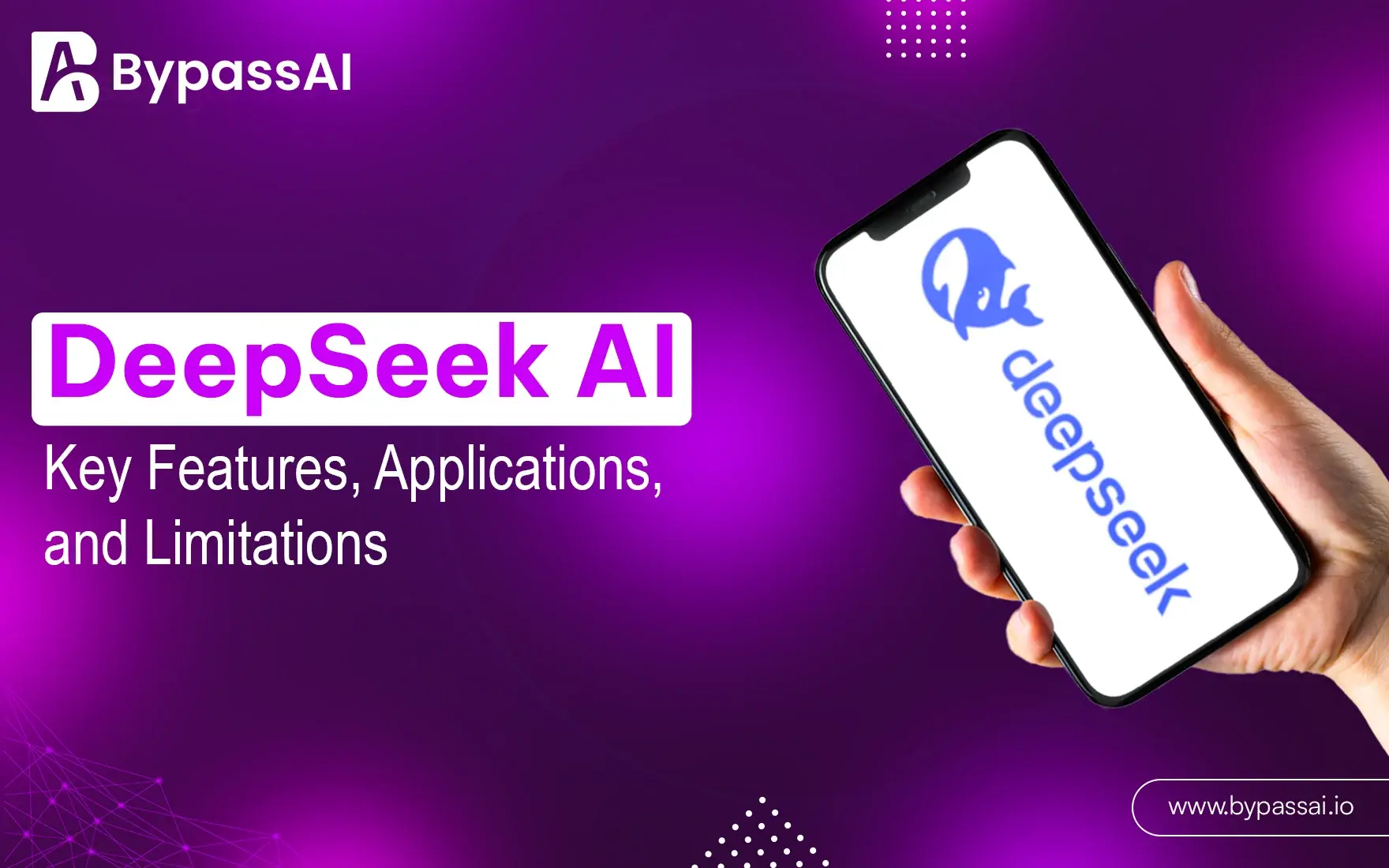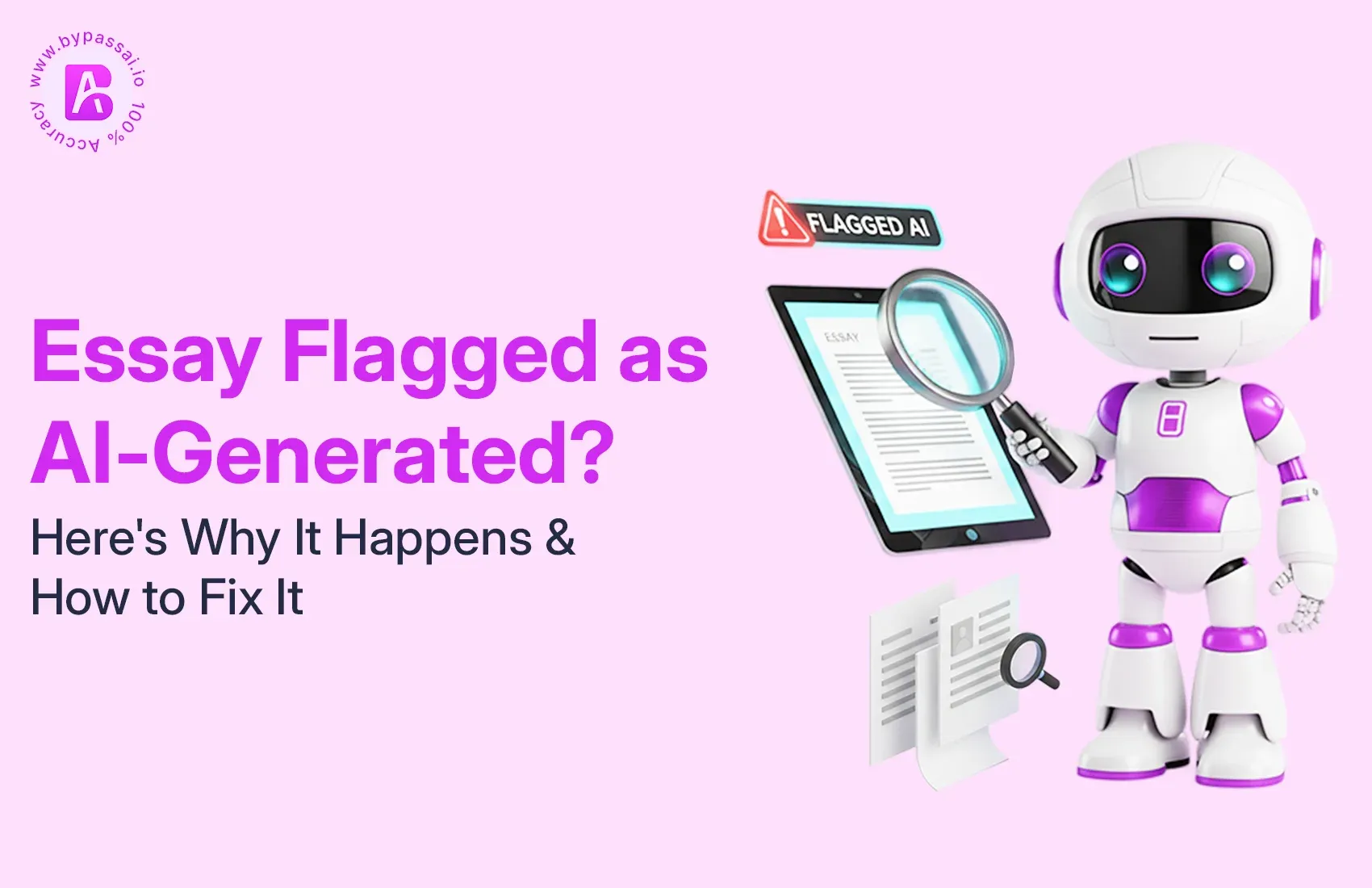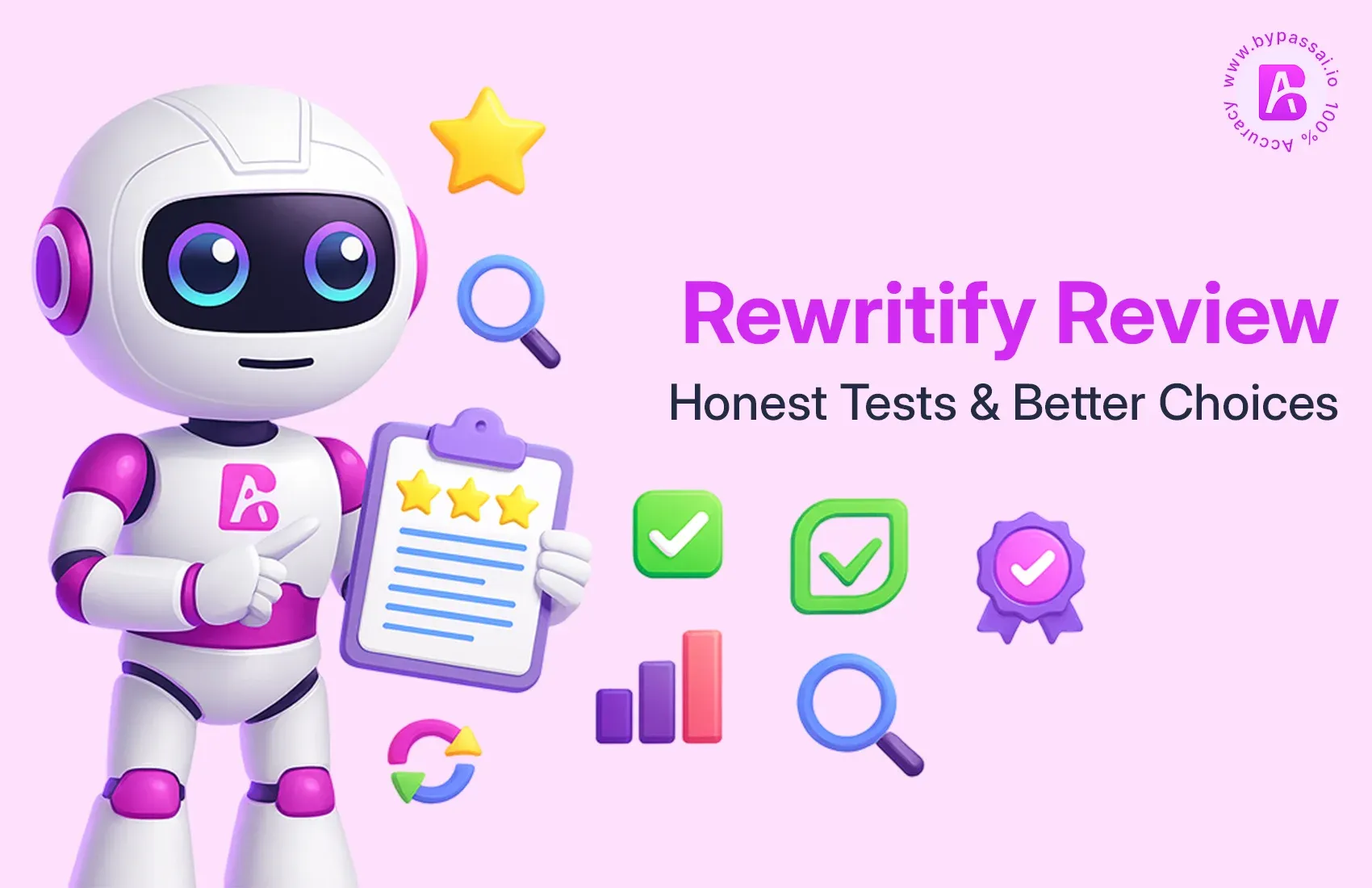Sign In
Welcome to Bypass AI! Sign in to continue your exploration of our platform with all its exciting features.
Forgot Password?
Don’t have an account ? Sign up
Sign Up
Embrace the Future with Bypass AI! Sign up now and let's rewrite the possibilities together.
You have an account ? Sign In
Enter OTP
We’ll send you an OTP on your registered email address
Back to Login
Forgot Password
We'll Send You An Email To Reset Your Password.
Back to Login
Enter OTP
We'll send you an email to reset your password.
Back to Login
Confirm Password
Please enter your new password.
TABLE OF CONTENTS
Quick Summary
What is DeepSeek AI?
Who Developed DeepSeek AI?
Key Features of DeepSeek AI
DeepSeek AI Architecture & Technical Overview
How Does DeepSeek AI Work?
DeepSeek AI vs. Other AI Models
DeepSeek-R1: How to Use It
Why DeepSeek AI is the Next Big Thing in AI
Applications in Various Industries
The Future of AI with DeepSeek
Challenges and Limitations
Conclusion
FAQs
I have seen the AI world evolving a lot in the last 5 years, and so many innovations and AI tools are being publicly launched daily. Many experts believe that the sector will grow at a rate of 35.9% between 2025 and 2030.
If you explore the platforms and tools in the AI community, then you will find tools ranging from many useful AI models to tools, but there are also some models which have been quite impactful, one of them is Deepseek. If you are a software developer, then the story of Deepseek will be very inspiring for you, and I have personally used Deepseek a lot.
The R1 When Deepseek's public version came out in 2025, it started by becoming very popular in the USA, leading to Deepseek overtaking ChatGPT on the App Store. Deepak AI platform is an exciting platform in the AI/tech community and has grown a lot in such a short time. Additionally, it has been scrutinized for security reasons in a number of countries because it is a Chinese company.
Today in this comprehensive blog, we will explore Deepseek AI along with its models, use cases, some challenges and at the end, I will provide you all the information based on my practical experience.
Quick Summary
DeepSeek AI is a Chinese-developed, open-source AI platform, and since its launch, this platform is known for its cost-effectiveness, efficiency, and performance, and this is the reason why DeepSeek has captured 4.34% market share of USA, 13.59% of India and 30.71% of China in such a short time. It uses Mixture-of-Experts (MoE) to deliver high accuracy while reducing computational load.
Deepseek AI is primarily being used extensively in healthcare, finance, education, e-commerce, and cybersecurity sectors and is also the favourite platform of many software developers.
Although it gives quite incredible results, it also has some flaws and limitations, due to which the results can sometimes be biased.
Our Focus in this Article:
- What is Deepseek, and how does it work?
- Who developed Deepseek, and what are its key features?
- In which sectors is Deepseek used the most and why?
- What are the future and limitations of Deepseek?
What is DeepSeek AI?
If we understand Deepseek AI in simple terms, then you can consider it as the next-gen Large Language Model (LLM) which understands the input of humans and generates and processes output as per their request, and then gives the final output.
Note: The output of Deepseek or any LLM platform depends on its model. For example, if you use the Deepseek R1 model, then its output and the output of Deepseek V3 will fluctuate.
Deepseek's R1 model can handle complex queries to mathematical problems and generate content as per your request. Deepseek's web search or R1 model is also widely used for real-time market trends and news. DeepSeek has maintained its strong position in the AI market, and has made itself a capable alternative to Western AI models like GPT-4 and Cloud AI. When the DeepSeek R1 model was launched in January 2025, its popularity increased significantly in the tech world.
Behind the growth of Deepseek AI, its Mixture-of-Experts architecture has played a very important role. Whenever you give any input, Deepseek uses specialist experts instead of generalists, so that you get final results fast, effectively and cheaper, and it also reduces resources in a very efficient way. This is the main reason why Deepseek's answers are so professional.
Most AI systems are quite closed, but Deepseek is an open-source project, which means anyone can study its architecture, improve upon it, and integrate it into their projects. This is the main reason why people have so much trust in Deepseek and its output.
Who Developed DeepSeek AI?
DeepSeek AI is owned by Hangzhou DeepSeek Artificial Intelligence Basic Technology Research Co., Ltd., founded in 2023 by Liang Wenfeng, and Liang also co-founded High-Flyer, a quantitative hedge fund in Hangzhou.
In just two years, DeepSeek’s development roadmap has been nothing short of impressive; that's the main reason DeepSeek is a recognised AI platform by the AI community today.
Dec 2023: DeepSeek LLM, this follows 67B parameters, close to GPT-4 level performance.
May 2024: DeepSeek-V2, In this model, the company has introduced MoE and multi-head latent attention for efficiency.
July 2024: DeepSeek-Coder-V2 is designed for developers with massive coding capabilities.
Well, I have personally tested Deepseek Coder-v2, and its overall accuracy is average, because it sometimes provides wrong structure code.
Dec 2024: DeepSeek-V3, it follows 671B parameters, advanced mixture-of-experts, FP8 mixed precision training.
Jan 2025: DeepSeek-R1, this model of DeepSeek is purely a learning-based reasoning model, and it is known for its complex problem-solving capabilities and DeepSeek mostly started getting growth from the R1 model.
DeepSeek-R1 model became quite popular in USA, India and south east Asia, and personally I have been using it for more than 2 months and still using it, I liked R1 model much better, and compared with models like Perplexity and Claude, I liked Deepseek R1 model much better, apart from this after this model the layout, options, font of the Deepseek platform were given an IOS touch, due to which you will get a very high experience of Deepseek on Android phone as well.
Key Features of DeepSeek AI
I have spent a lot of time on DeepSeek AI for different tasks, and let me tell you, on that basis, what features you can get in DeepSeek AI.
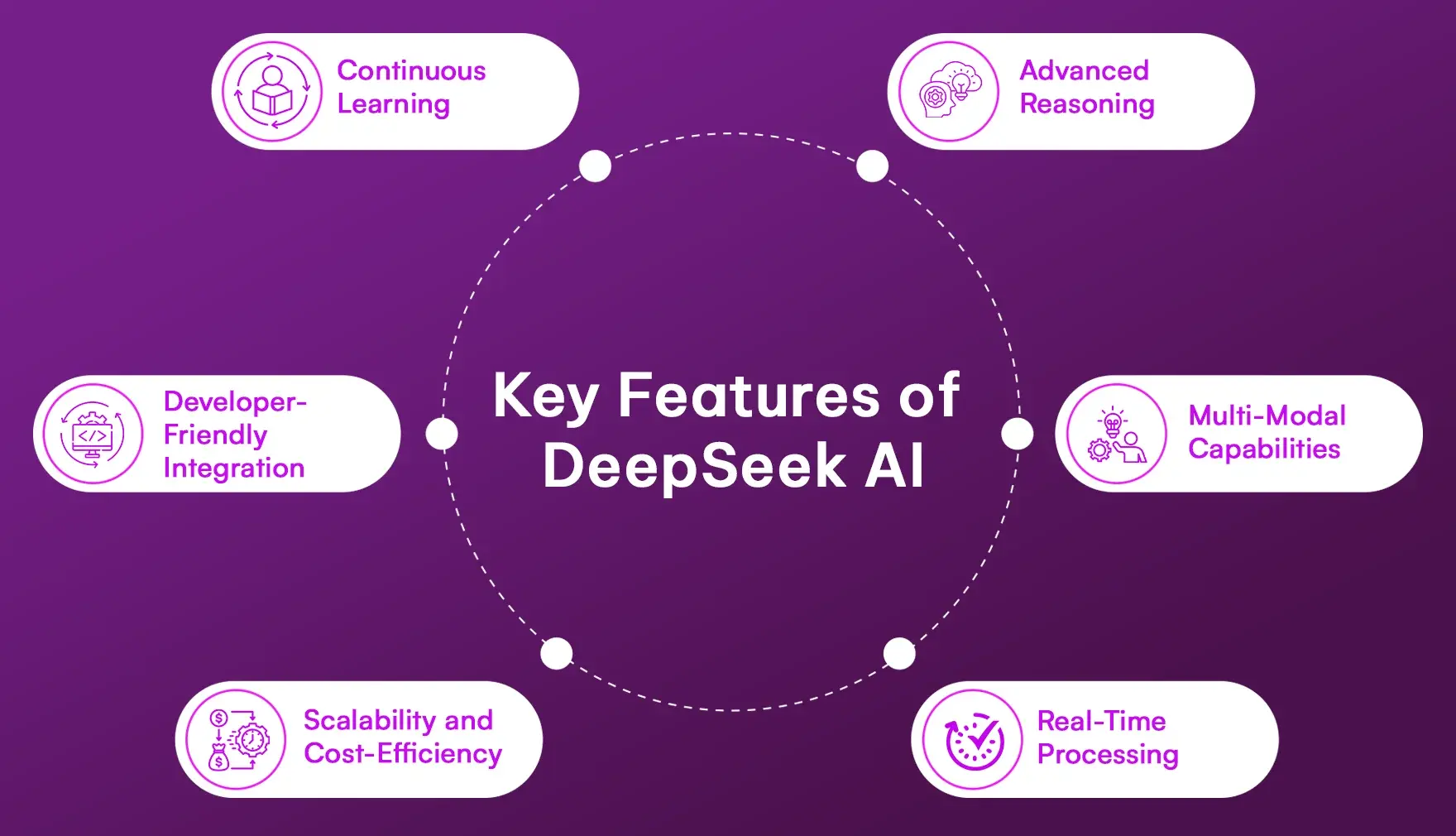
1. Advanced Reasoning
As we know, DeepSeek’s R1 model is designed for high-level logical thinking and multi-step problem solving, and its speciality is that it solves complex problems by dividing them into smaller segments. Hence, it can easily handle mathematics, logic puzzles, and computer programming. Due to these advanced reasoning capabilities, Deepseek is a better platform than a question-answer solver.
As per the 2024 AIME benchmarks, DeepSeek’s performance is significantly better and it even performed better than OpenAI’s o1-1217 model in many tests.
2. Multi-Modal Capabilities
Although DeepSeek started as a text-first AI, its newer iterations are moving toward multi-modal intelligence, so it can easily manage different inputs and outputs such as text, images, and potentially video.
Deepseek has created multiple range of use cases, providing security footage, creating visual content from text prompts and analyzing it. And he can also understand complex charts and diagrams.
I think by understanding and processing multiple formats, DeepSeek can become a versatile assistant for journalists, medical professionals, designers, educators, and many other fields where information comes in more than just plain text.
3. Real-Time Processing
Working at a fast speed is very important for any tool, and DeepSeek has a huge critical advantage in this. Whether you're trying to identify suspicious transactions in banking, monitoring live traffic flows in smart cities, or give rapid medical data analysis, it can give very smart and efficient results. It answers most of the queries in seconds, so if you want to choose a fast model, then you can prefer the Deepseak R1 model.
The real-time processing capabilities of Deepseek ensure quick decision-making, which is very important in time-sensitive industries like healthcare, finance, law enforcement, and logistics.
Deepseek uses speed and accuracy so well that it not only saves time but also prevents a lot of losses and fraud. And it also helps a lot in cost reduction, along with the safety of different operations.
4. Scalability and Cost-Efficiency
As we know, DeepSeek uses a Mixture of Experts (MoE) architecture, which means that instead of activating its entire AI model for every task, it only uses the necessary “expert” parts. This results in reduced energy usage and significantly lower operational costs, without sacrificing performance quality. Mostly local retailers or small startups use Deepseek for different operations and to gain some information.
This architecture makes it perfect for businesses that want powerful AI but must also consider budget and sustainability.
I will advise you to try asking industry-oriented questions in Deepseek once you understand how Mixture of Experts (MoE) works.
5. Developer-Friendly Integration
DeepSeek AI structure has been built with flexibility in mind, which is why DeepSeek provides its own API and open-source framework. This makes it easier for developers to integrate DeepSeek into their workflows, apps, or platforms without unnecessary complexity.
Since it’s open-source, developers can also modify its core functionality to suit industry-specific requirements, whether it’s fine-tuning a customer service chatbot, building a specialized data analysis tool, or embedding AI into an existing SaaS product. This adaptability encourages innovation and faster deployment of AI-powered solutions.
6. Continuous Learning
Static models become outdated after a few years, but Deepseek models have learning and adaptability capabilities which adapt themselves to new technology as per new learning and updates, and they keep improving themselves with time.
Whenever you create any interaction, whether it is input or output, it helps Deepseek to refine its knowledge and performance. This makes the system more accurate, context-aware, and aligned with user needs as it is used.
It’s similar to a human gaining expertise through experience, meaning that the longer DeepSeek is implemented in a workflow, the smarter and more effective it becomes.
DeepSeek AI Architecture & Technical Overview
Deepseek outputs your answers like specialists, not generalists, and its Mixture-of-Experts setup ensures that for each query, only the relevant experts get activated. This boosts efficiency and accuracy.
Some of Deepseek AI's model training involves a mix of code (87%) and natural language (13%), making it especially good at programming-related tasks.
Let's know a fact that you may find quite surprising: DeepSeek-R1 was trained for $6 million, while GPT-4 was trained for $100 million; from this, you can get an idea of the future potential of DeepSeek.
On the hardware side, DeepSeek made a bold move by training on Nvidia H800 chips instead of restricted H100S, proving that top-tier AI doesn’t require the most expensive GPUs if you optimize the process smartly.
How Does DeepSeek AI Work?
Let us know how DeepSeek AI works and what its process is from input to output.
1. Input Processing
When you submit a query to Deepseek AI, whether the question is simple or complex, Deepseek's AI processing not only reads the words but also tries to understand the intent of your input. For this, it breaks the query request into smaller and logical components so that it can find out exactly what you asked. These steps help the AI understand the context of the user's questions so that it can provide relevant answers accordingly.
2. Expert Selection
As we know, Deepseek uses Mixture of Experts (MoE), according to which it activates its own task expert as per the question you ask. So that you get the answer from the relevant specialist, and the advantage of Deepseek is that it saves a lot of its resources, because mostly in LLM queries, they try to find the answer by activating all their experts, due to which means they have to invest more resources. Due to this, their per search cost also remains quite high.
For example: If you have asked a question related to mathematics, then the Deepseek model will try to get the answer from its math-focused expert rather than an image analysis expert. When experts are used according to the queries, their efficiency and performance are greatly enhanced, and people get relevant answers.
3. Computation & Reasoning
Once Deepseek's algorithm has selected the right expert, Deepseek uses its model's capabilities and expert experience to process that query request simultaneously. Deepseek uses chain-of-thought reasoning for answers, which helps it try to understand the context logically before giving the final answer. And it is especially powerful for complex tasks like multi-step math problems, coding challenges, or logical puzzles, where critical thinking is essential.
4. Output Generation
Deepseek gives the final response after understanding the entire context, and its speciality is that whatever answer it gives, it will try to keep it in natural language, and the answer will always feel context-aware. And this human-like communication style of Deepseek ensures that the answer is always easy to understand so that the users do not face any difficulty, and the originality of the context is maintained.
5. Feedback Loop
I personally liked this system of Deepseek a lot because when it gives the final answer, it learns a lot from that answer and the user's interaction, and analyzes all the user's feedback very deeply. This increases its reasoning capabilities over time, and it tries not to repeat its past mistakes in future. As the Deepseek algorithm does new learning, its accuracy and responsive capabilities get enhanced further.
DeepSeek AI vs. Other AI Models
I have used almost all the AI models, be it ChatGPT or Google Gemini, or Anthropic Cloud. And to understand any AI model, it is very important that we compare it with similar competitors, so let’s compare it with Deepseek’s top model.
DeepSeek AI vs. ChatGPT
I feel that Deepseek is a better and cheaper open-source alternative to ChatGPT, which makes it more accessible for developers and organizations, and being open source makes it easy to customize it according to specific needs.
While ChatGPT gives more polished results, it definitely enhances the user experience, and in ChatGPT, you definitely get features like image generation and voice interaction, which users like a lot and this also gives OpenAI a competitive edge. But Deepseek's open architecture gives users more flexibility, which can be used by developers for modification and integration with different platforms and tools. If you are among those people who need important features but at a budget price, then you can prefer Deepseek, because it is overall quite affordable compared with other LLM models.
DeepSeek AI vs. Google Gemini
When you compare Deepseek AI with Google Gemini, you will find that Deepseek can also provide the latest information using real-time processing, and because of its Mixture of Experts (MoE) design, it gives you very relevant answers, and Deepseek also benefits a lot from this because it saves a lot of its resources.
Google Gemini gets a lot of advantage due to the support of Google because the Google ecosystem has the largest database in the world, due to which users can use Gemini in Google search or in different Google products like Gmail, Docs. Hence, Google Gemini is already the best option for business. Deepseek is good for those who need faster responses and don’t have a high budget.
DeepSeek AI vs. Anthropic Claude
We all know Anthropic’s Cloud for its ethical transparency and focus on safety. Deepseek’s overall performance and reasoning capabilities match those of Cloud, but Deepseek has the advantage of being open source, due to which it has more trust in the AI community. And being open source, Deepseek's models have more flexibility and adaptability as compared to Claude's.
I would recommend Cloud to organizations that are very strict regarding AI safety frameworks. Otherwise, Deepseek is a good choice for those who want to balance performance and cost efficiency. Overall, Deepseek is easier to deploy than Cloud.
Pro Tip: All the models are already quite advanced, so before choosing any model, you should test it for your tasks. This will give you a better idea about which model is best for you.
DeepSeek-R1: How to Use It
It is quite easy to use the Deepseek R1 model; you can use it on any device or on the web, and the method of using Deepseek is overall the same as all other models. You can use the R1 model by logging in or without logging in.
- First of all, install DeepSeek on your Android/iOS device or visit the official website of DeepSeek in your browser.
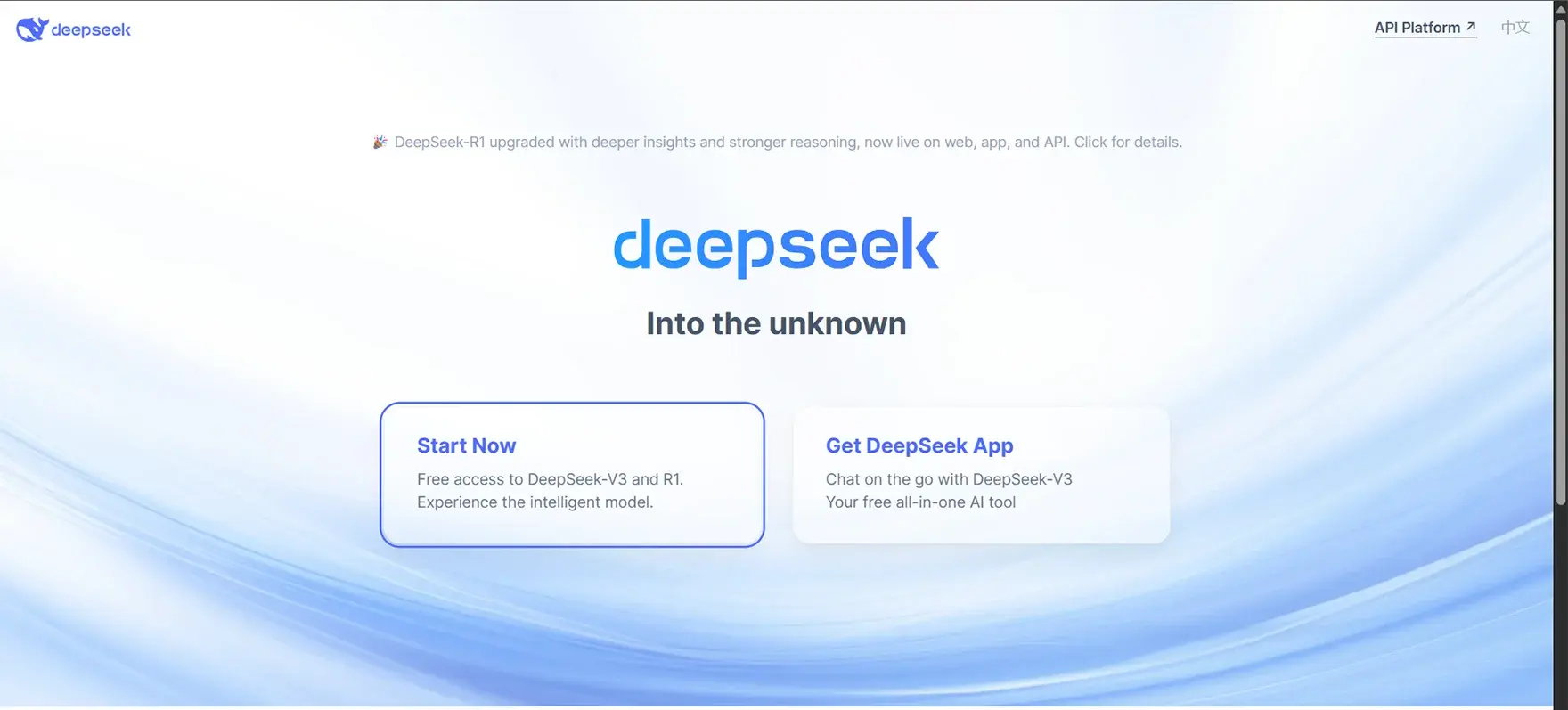
- If you are a beginner user, then first of all, you have to tap on sign-up, after that you have to fill in your mobile number or email address and tap next, and if you have chosen a mobile number, then make sure to select your country code before your number.

After this, you have to fill in your basic details like your name, gender, and profession.
You have to verify yourself by filling in the OTP that will come to the email or number you provided.
After your sign-up is successful, you will be redirected to the Deepseek homepage.
Then select the DeepSeek model you want to chat with; apart from this, you can also choose a particular feature like deep reasoning or web search.
Then fill in your query or prompt and submit it, and you will get the final output in 30 seconds to 2 minutes.
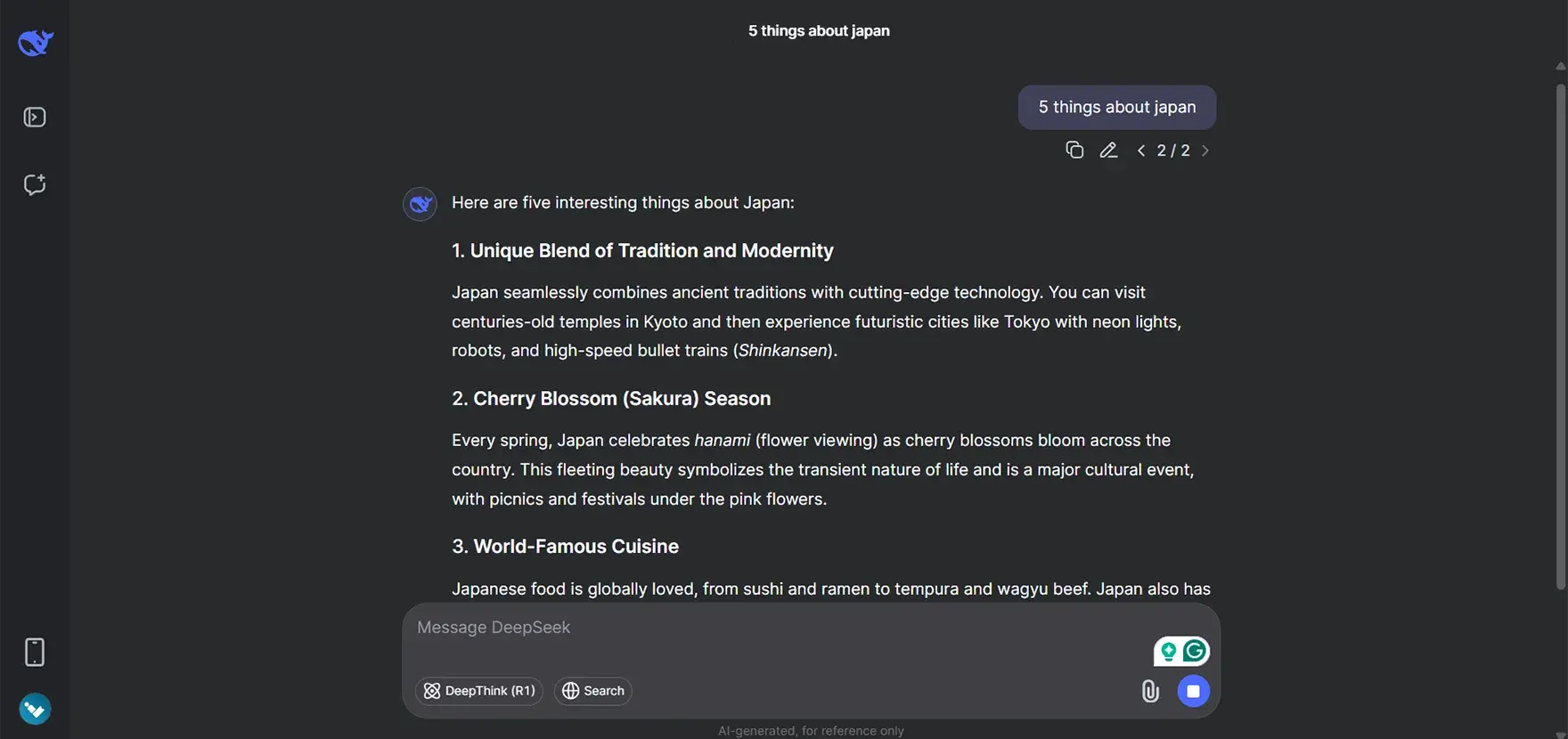
My Recommendation: If you want accurate results, then you should give clear prompts and use context-rich queries, and enable API integration for automation tasks.
Why DeepSeek AI is the Next Big Thing in AI
However, there are many reasons why DeepSeek has become so popular in the AI community, mainly the above 3 main reasons are known.
1. Affordability Without Compromise
In just 1 year, Deepseek is an inspiration for many new AI companies because earlier, everyone thought that building an AI model was very challenging and costly, but Deepseek was trained in just 5 million dollars. This is why Deepseek is a cost-efficient model because its architecture is very resource-saving. Deepseek's reasoning and speeds will be liked by those who want to use advanced AI on a low budget.
Due to Deepseek, access to advanced and high-performance became accessible to everyone, be it small startups, researchers, educators, and small businesses, but earlier, all the platforms were available only to the tech giants.
2. Open-Source Freedom
Most AI models are closed, but DeepSeek is completely open-source, meaning anyone can study DeepSeek's structure, algorithm and can modify and enhance it if they want. It also encourages global collaboration and accelerates innovation. And because of AI companies like Deepseek, there is no market dependency on a single company, and people have different AI options.
Developers from different countries can modify and enhance Deepseek for sectors ranging from healthcare to trading, without worrying about restrictive licenses.
3. Technical Efficiency
DeepSeek proves you don't need a billion-dollar GPU cluster to build a competitive AI model.
Due to its Mixture of Experts (MoE) system, it activates only the necessary components for each query, saving computing resources and energy. This not only lowers costs but also makes AI more sustainable and environmentally friendly.
Applications in Various Industries
Deepseek is used in many sectors for different purposes, and as we know that Deepseek's output is specialist, hence its industry professionalism remains high.
Healthcare
DeepSeek AI can transform healthcare by enabling early disease detection through advanced pattern recognition in medical scans, accelerating drug discovery with predictive modelling, and analyzing patient data for better treatment plans. Its real-time processing helps doctors make faster, more accurate decisions, improving patient outcomes and reducing diagnostic errors.
Finance
Deepseek can play a very important role in real-time transactional security, as it can easily spot unusual transaction patterns within seconds and do fraud detection. And it supports algorithmic trading by processing market data at high speed. Apart from this, it also gives automated financial advice to investors so that they do not have to rely on the data manually, and Deepseek's model automatically does the data analysis.
Education
Deepseek can serve as a personal AI tutor and can also easily provide personalized explanations and interactive learning experiences to students. I have also used it for educational purposes, and you can also use Deepseek for personalized learning, and by this, you can turn your weaknesses into your strengths.
E-commerce
Deepseek can handle product recommendation operations in an e-commerce business very easily, for this, they give personalized product recommendations by understanding user behaviour. This boosts the sales of e-commerce businesses, and they can improve their inventory even more in an optimized way and with this, they can manage the demand and supply cycle very smartly. Customer experience also increases a lot due to intelligent search and chatbot integration.
Cyber security
In cybersecurity, Deepseek AI has PSS capabilities that allow companies to automate threat detection in their systems, thus preventing data breaches. Since Deepseek's security system can easily perform vulnerability scanning, it can identify weak points in your systems. Automated responses minimize damages and also reduce downtime.
The Future of AI with DeepSeek
Deepseek's current R1 model is already quite advanced, and it supports multi-modal capabilities. Many experts say that Deepseek's future models will be even more advanced because, in one year, when this model can be so capable, if more R&D is done on it then its capabilities and learning speed can become faster. In the next models, capabilities like previous chat learning will be further improved. Apart from this, Deepseek's team is further enhancing the previous coding model.
Deepseek's API will become more advanced, and in the next few years, this will also help local businesses a lot.
Challenges and Limitations
As advanced as Deepseek is, it also has its flaws. Let’s get into the details of the challenges faced due to Deepseek.
1. Ethical & Political Bias
As we know, Deepseek was developed in China, there is a high possibility that some responses may be influenced by state-approved narratives or cultural perspectives. This can affect the neutrality of certain topics, especially those related to politics, history, or sensitive global issues. For international users, this bias may require them to do extra fact-checking to ensure the accuracy of the information, which may take extra time.
Many experts say that due to tensions between the USA and China, Deepseek may be banned by the governments in India and the USA in the future.
2. Language Coherence Issues
Deepseek's R1 model supports and handles multiple languages, which is why it sometimes mixes languages in a single output, especially when you switch from English to Chinese. This reduces the clarity of the final professional output. And in cases of multilingual use, extra editing is required before final publication.
3. Computational Requirements
Despite the Mixture of Experts (MoE) efficiency in Deepseek, deploying the largest version of Deepseek requires high-end hardware. Organizations that do not have access to powerful GPUs or specialized infrastructure will face many challenges in deploying it. Therefore, most businesses will deploy cloud-based instead of hardware.
4. Security Concerns
The ClickHouse database vulnerability that occurred in the past has given us a lot of insight into the potential security risks of AI systems. As we know that the open-source nature of Deepseek allows developers to make modifications, and hence vulnerabilities can be publicly exposed; hence, it requires careful monitoring and cybersecurity best practices should be followed during deployment.
Conclusion
DeepSeek AI is also an inspiration for many AI companies because DeepSeek has proved that advanced AI models can be developed even on a low budget. DeepSeek is gaining worldwide popularity very quickly as compared to ChatGPT and Claude because its overall results are more personalized and full of expertise.
Deepseek's current R1 model is better for different tasks, be it educational or operational.
So my suggestion to you would be that if you are a student or any professional, you should use different AI models, be it ChatGPT or Deepseek, this will improve your AI experience and it will also help you a lot in your work.
FAQs
1. How accurate is DeepSeek AI compared to other models?
Overall, DeepSeek performs well compared to other models, and you can prefer DeepSeek for reasoning. It scores quite well in problem-solving benchmarks, and it also performs better than models like ChatGPT and Cloud in many tasks.
2. Is DeepSeek AI free to use?
Yes, the base version of Deepseek is free and open source, but for enterprise-level deployments or API usage, you may need to subscribe to it, and you will also have to invest in hosting for the API.
3. What programming languages does DeepSeek AI support?
DeepSeek AI platform supports multiple languages, including Python, JavaScript, and Java, making it easy to integrate and making it suitable for development in different environments. As I experienced, Deepseek coding accuracy can fluctuate, so always do manual checks.
4. Can DeepSeek AI replace human workers?
While it can automate many tasks, Deepseek or any other models will never be able to replace human workers, because LLM models have limited data, so they will be used for productivity, and human workers will be best for the latest and emotion-based information.
5. How does DeepSeek AI ensure data privacy?
Overall, data handling depends on the deployment, which is a self-hosted setups that save data on in-house servers, while cloud hosting relies on the provider’s security protocols.
6. What are the hardware requirements for DeepSeek AI?
If you want to use DeepSeek AI only for normal tasks, you can use it through an application on Android or iOS devices. There is no such hardware requirement, as it is already cloud-based processing, but if you use Deepseek’s API, then you may need high-end hardware for it.

